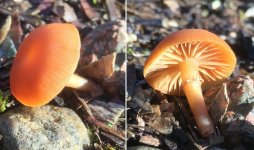Hi Lazza, Julie and everyone else,
There are a few immediate clues that this can't be a waxcap. I'll try to explain:
1- Habitat: Waxcaps are (by and large) nitrophobes and are generally associated with open, unimproved habitats such as meadows. Every now and then you might see a small group in woodland (usually growing with mosses) but never amongst woodchips.
2 - Veil: The stem clearly has a nice, fluffy ring-zone, which is an indication of a veil. Waxcaps never have veils.
3 - Spore print: The fluffy fibrils on the stem seem to have caught a brownish spore deposit. Waxcaps have white spores.
It's Tubaria furfuracea, a late-fruiting and quite variable species that seems to quite like urban environments, often growing in flowerbeds etc.
Cheers,
Nick





